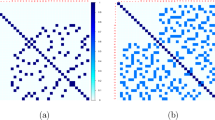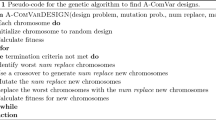Abstract
Conference designs are \(n \times k\) matrices, \(k \le n\), with orthogonal columns, one zero in each column, at most one zero in each row, and \(-1\) and \(+1\) entries elsewhere. Conference designs with \(k=n\) are called conference matrices. Definitive screening designs (DSDs) are constructed by folding over a conference design and adding a row vector of zeros. We propose methodology for the systematic enumeration of conference designs with a specified number of rows and columns, and thereby for the systematic enumeration of the corresponding DSDs. We demonstrate its potential by enumerating all conference designs with up to 24 rows and columns, and thus all DSDs with up to 49 runs. A large fraction of these DSDs cannot be obtained from conference matrices and is therefore new to the literature. We identify DSDs that minimize the correlation among contrast vectors of second-order effects and provide them in supplementary files.
Similar content being viewed by others
References
Atkinson, A., Donev, A., Tobias, R.: Optimum Experimental Designs, with SAS. OUP, Oxford (2007)
Cheng, C., Deng, L., Tang, B.: Generalized minimum aberration and design efficiency for nonregular fractional factorial designs. Stat. Sin. 12, 991–1000 (2002)
Cheng, S.W., Ye, K.Q.: Geometric isomorphism and minimum aberration for factorial designs with quantitative factors. Ann. Stat. 32, 2168–2185 (2004)
Colbourn, C.J., Dinitz, J.H.: Handbook of Combinatorial Designs, 2nd edn. Chapman and Hall/CRC, Boca Raton (2006)
Cuervo, D.P., Goos, P., Sörensen, K.: Optimal design of large-scale screening experiments: a critical look at the coordinate-exchange algorithm. Stat. Comput. 26, 15–28 (2016)
Dougherty, S., Simpson, J.R., Hill, R.R., Pignatiello, J.J., White, E.D.: Effect of heredity and sparsity on second-order screening design performance. Qual. Reliab. Eng. Int. 31, 355–368 (2015)
Eendebak, P., Vazquez, A.: OApackage: a Python package for generation and analysis of orthogonal arrays, optimal designs and conference designs. J. Open Sour. Softw. 4, 1097 (2019)
Fidaleo, M., Lavecchia, R., Petrucci, E., Zuorro, A.: Application of a novel definitive screening design to decolorization of an azo dye on boron-doped diamond electrodes. Int. J. Environ. Sci. Technol. 13, 835–842 (2016)
Georgiou, S.D., Stylianou, S., Aggarwal, M.: Efficient three-level screening designs using weighing matrices. Statistics 48, 815–833 (2014)
Greig, M., Haanpää, H., Kaski, P.: On the coexistence of conference matrices and near resolvable \(2-(2k + 1, k, k - 1)\) designs. J. Comb. Theory Ser. A 113, 703–711 (2006)
Jones, B., Lanzerath, M.: A novel application of a definitive screening design: a case study. Qual. Eng. 33, 563–569 (2021)
Jones, B., Nachtsheim, C.J.: A class of three-level designs for definitive screening in the presence of second-order effects. J. Qual. Technol. 43, 1–15 (2011)
Jones, B., Nachtsheim, C.J.: Definitive screening designs with added two-level categorical factors. J. Qual. Technol. 45, 121–129 (2013)
Jones, B., Nachtsheim, C.J.: Effective design-based model selection for definitive screening designs. Technometrics 59, 319–329 (2017)
Libbrecht, W., Deruyck, F., Poelman, H., Verberckmoes, A., Thybaut, J., De Clercq, J., Van Der Voort, P.: Optimization of soft templated mesoporous carbon synthesis using Definitive Screening Design. Chem. Eng. J. 259, 126–134 (2015)
Maestroni, B.M., Vazquez, A.R., Avossa, V., Goos, P., Cesio, V., Heinzen, H., Riener, J., Cannavan, A.: Ruggedness testing of an analytical method for pesticide residues in potato. Accred. Qual. Assur. 23, 303–316 (2018)
Mee, R.W., Schoen, E.D., Edwards, D.E.: Selecting an orthogonal or non-orthogonal two-level design for screening. Technometrics 59, 305–318 (2017)
Nachtsheim, A.C., Shen, W., Lin, D.K.J.: Two-level augmented definitve screening designs. J. Qual. Technol. 49, 93–107 (2017)
Nguyen, N.-K., Pham, T.-D.: Small mixed-level screening designs with orthogonal quadratic effects. J. Qual. Technol. 48, 405–414 (2016)
Nguyen, N.-K., Stylianou, S.: Constructing definitive screening designs using cyclic generators. J. Stat. Theory Pract. 7, 713–724 (2013)
Núñez Ares, J., Goos, P.: Enumeration and multicriteria selection of orthogonal minimally aliased response surface designs. Technometrics 62, 21–36 (2020)
Olsen, R.E., Bartholomew, C.H., Enfield, D.B., Lawson, J.S., Rohbock, N., Scott, B.S., Woodfield, B.F.: Optimizing the synthesis and properties of Al-modified anatase catalyst supports by statistical experimental design. J. Porous Mater. 21, 827–837 (2014)
Phoa, F.K.H., Lin, D.K.J.: A systematic approach for the construction of definitive screening designs. Stat. Sin. 25, 853–861 (2015)
Renzi, P., Kronig, C., Carlone, A., Eröksüz, S., Berkessel, A., Bella, M.: Kinetic resolution of oxazinones: rational exploration of chemical space through the design of experiments. Chem. Eur. J. 20, 11768–11775 (2014)
Schoen, E.D., Eendebak, P.T., Goos, P.: A classification criterion for definitive screening designs. Ann. Stat. 47, 1179–1202 (2019)
Schoen, E.D., Eendebak, P.T., Nguyen, M.V.M.: Complete enumeration of pure-level and mixed-level orthogonal arrays. J. Comb. Des. 18, 123–140 (2010)
Schoen, E.D., Vo-Thanh, N., Goos, P.: Two-level orthogonal screening designs with 24, 28, 32, and 36 runs. J. Am. Stat. Assoc. 112, 1354–1369 (2017)
Tai, M., Ly, A., Leung, I., Nayar, G.: Efficient high-throughput biological process characterization: definitive screening design with the Ambr250 bioreactor system. Biotechnol. Prog. 31, 1388–1395 (2015)
Vazquez, A.R., Goos, P., Schoen, E.D.: Projections of definitive screening designs by dropping columns: selection and evaluation. Technometrics 62, 37–47 (2020)
Xiao, L., Lin, D.K., Bai, F.: Constructing definitive screening designs using conference matrices. J. Qual. Technol. 44, 1–7 (2012)
Acknowledgements
The authors are grateful to two anonymous referees, whose comments were helpful to clarify the text.
Author information
Authors and Affiliations
Corresponding author
Ethics declarations
Conflict of interest
The authors declare that they have no conflict of interest.
Additional information
Publisher's Note
Springer Nature remains neutral with regard to jurisdictional claims in published maps and institutional affiliations.
This research was financially supported by Fonds Wetenschappelijk Onderzoek (FWO, Flanders, Belgium).
Supplementary Information
Below is the link to the electronic supplementary material.
11222_2022_10171_MOESM1_ESM.zip
Sample code.py: python code to enumerate and output conference designs. Table 5 designs.zip: conference designs to build all DSDs evaluated in Table 5. (zip 13 KB).
Appendix: LM0 check function
Appendix: LM0 check function
The reduction algorithm in Sect. 3.3 calls the LM0 check function given in Algorithm 4, which itself calls a continuation function given in Algorithm 5. The purpose of the LM0 check function is to determine whether or not an input design is of LM0 form. To this end, it performs column permutations, row permutations, sign switches of rows, and sign switches of columns to check whether these operations result in a lexicographically larger design. As soon as a lexicographically larger design is found, the procedure stops and returns a \({ False}\) for the input design. The sign switches and a small portion of the permutations are addressed in Algorithm 4. All remaining column permutations are addressed in Algorithm 5.

In lines 1 and 2, Algorithm 4 considers all designs A in which column 1 is interchanged with any of the columns \(1,\ldots ,(k+1)\), thereby including the option that the first column stays in its original position. Next, in lines 3 and 4, the rows are sorted and sign switches of the rows are applied until the first column is in the largest form possible: a zero entry in the first position \(a_{1,1}\) and entries of 1 in all other positions \(a_{i,1}\), where \(i>1\). At this point, the design can only be made lexicographically larger by applying a sign switch to row 1 or to columns \(2,\ldots ,(k+1)\) so that all columns other than the first start with a 1. These options are explored in lines 5–8 of Algorithm 4. At this point, all sign switches that might make the current design lexicographically larger are exhausted. However, there may still be column permutations that result in a lexicographically larger design. That part of the LM0 check is performed by Algorithm 5.

Algorithm 5 carries out additional column permutations as well as the actual LM0 check between the original input design K and the design modified by the sign switches and permutations of Algorithms 4 and 5. The input of Algorithm 5 is the original input design K, the modified design and the leftmost column c that is to be permuted with columns \(c,c+1,\ldots ,k+1\). In its line 2, Algorithm 5 starts by conducting column permutations involving the current column c and sorting the rows such that earlier columns remain unchanged. This qualification is necessary because the ‘larger than’ operation works column by column. If the sorting would change the row order of the first \(c-1\) columns, the current design would not be as large as possible.
After the sorting, the current column is tested against the corresponding column in the original design K (lines 4–9). If the current column is lexicographically larger, then the original design is not of LM0 form. If both columns are equal, further column permutations are invoked by calling the algorithm recursively using a new current column. Finally, if the current column it is smaller than the corresponding column in K, a new iteration of the for loop is started.
Rights and permissions
Springer Nature or its licensor (e.g. a society or other partner) holds exclusive rights to this article under a publishing agreement with the author(s) or other rightsholder(s); author self-archiving of the accepted manuscript version of this article is solely governed by the terms of such publishing agreement and applicable law.
About this article
Cite this article
Schoen, E.D., Eendebak, P.T., Vazquez, A.R. et al. Systematic enumeration of definitive screening designs. Stat Comput 32, 109 (2022). https://doi.org/10.1007/s11222-022-10171-6
Received:
Accepted:
Published:
DOI: https://doi.org/10.1007/s11222-022-10171-6




